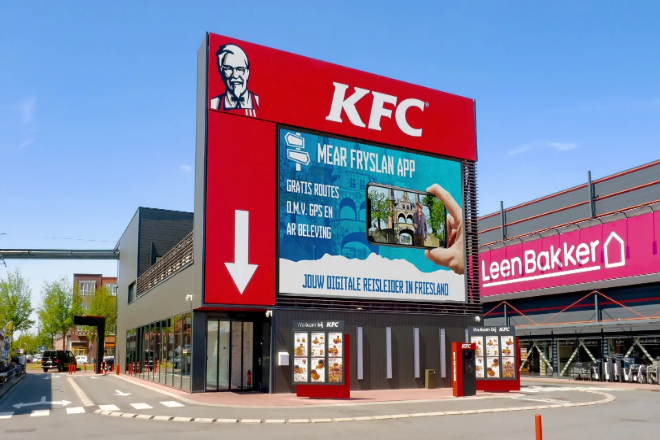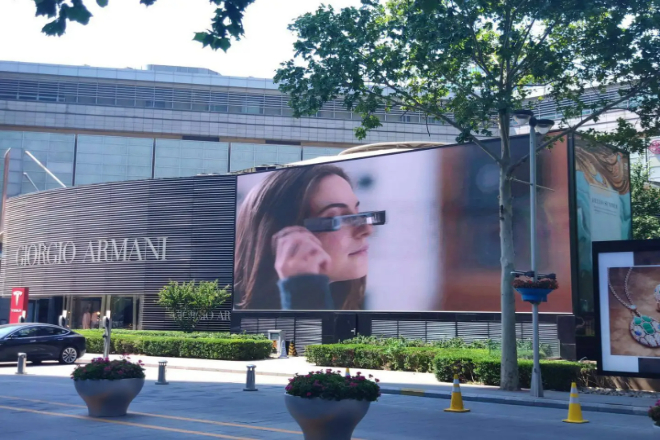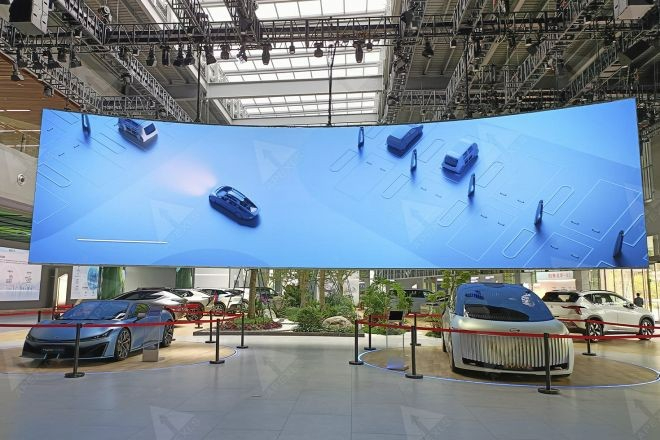Introduction

Whether it is a bustling commercial street, a government agency’s bulletin board, or even a stadium and square, we can see LED displays installed outdoors.
Among them, outdoor LED displays and semi-outdoor LED displays are two common types, each playing an important role.
However, for many people, there seems to be no obvious difference between outdoor LED displays and semi-outdoor LED displays, and some even think they are the same product. So, what is the truth?
1. Overview of outdoor LED displays

As the name suggests, outdoor LED displays refer to LED display screens used outdoors. Its features are:
- High brightness:
The brightness of outdoor LED displays is very high and can remain clearly visible under direct sunlight. This allows it to effectively attract the audience’s attention in various outdoor environments.
- High definition:
Using advanced display technology, outdoor LED displays can present high-definition images. Whether it is text, images, or videos, they can be presented in a delicate and clear way.
- Large size:
The area of outdoor LED displays is generally tens of square meters to hundreds of square meters or even larger, which can cover a wide range of vision and provide shocking visual effects.
Stability and reliability in harsh environments: Outdoor LED displays are usually windproof, rainproof, waterproof, and dustproof and can work stably in various harsh environments.
At the same time, it also has lightning protection and anti-interference characteristics to ensure reliable operation in various complex environments.
1). Common application scenarios
- Public places:
Such as stations, docks, airports, shopping malls, hospitals, hotels, etc. In these places, outdoor LED displays can be used to play advertisements, news, weather forecasts, and other information to provide convenient life services for the public.
- Commercial streets:
In busy areas such as commercial pedestrian streets and shopping centers, outdoor LED displays have become an important means for businesses to display their brand image and promote their products.
It can play dynamic advertisements and promotional information to attract passers-by to stop and watch.
- Government agencies:
Government agencies also widely use outdoor LED displays for information dissemination. For example, LED displays are set up in front of government buildings, squares, etc., to play government announcements, event promotions, and other information to improve the transparency and credibility of the government.
2. Overview of semi-outdoor LED display screen

A semi-outdoor LED display screen is a display screen between outdoor and indoor use environments. It combines the high brightness and high definition of outdoor LED display screens and has certain waterproof and dustproof capabilities.
However, compared with full-outdoor LED display screens, its protection performance is slightly lower, and it is more suitable for installation in semi-sheltered outdoor areas.
The characteristics of semi-outdoor LED display screens are outdoor and indoor. It can be used in outdoor environments and withstand a certain degree of sunlight, rain, wind, sand, and other natural factors, but it does not need to have extremely high protection performance like full-outdoor LED display screens.
Therefore, it is more suitable for those places that require outdoor display functions but have relatively mild environments and more shelter.
1). Application scenarios
- Plaza:
In the plaza area of the city, semi-outdoor LED display screens can be used to play city image promotional videos, public service advertisements, cultural performance previews, and other content to provide citizens with a rich and colorful cultural life.
In or around the stadium, semi-outdoor LED display screens can be used to display game data, advertising information, sponsor logos, etc., in real-time to provide audiences with a better viewing experience.
- Commercial Street:
At the entrance, corner, or important node of the commercial street, the semi-outdoor LED display can be used to play the promotional information of merchants, real-time weather forecasts, city navigation, and other content to attract customers to stay and shop.
3. What is the relationship between outdoor LED displays and semi-outdoor LED displays?
Outdoor LED displays and semi-outdoor LED displays are like two brothers in the LED display family. They have their own specialties and applicable occasions, but they all carry the common genes of the LED display family.
Speaking of which, the most similar thing about them is that they all use LED technology to display information.
Whether it is images, text, or videos, they can be presented clearly and brightly. Moreover, they all have a certain ability to resist environmental interference and are not so easily affected by wind and rain.
However, to be honest, the outdoor LED display is a “tough guy.” It is designed to be particularly tough and can withstand all kinds of bad weather. Rainy days, wind and sand, high temperatures, and low temperatures are not a problem for it.
You can often see it in open outdoor places such as streets, squares, and stadiums, playing various advertisements, live broadcasts, or information.
As for the semi-outdoor LED display, it is like the “gentle brother” of the outdoor LED display. Its protection level is not as high as that of the outdoor LED display, but it is also waterproof and dustproof, and it is still no problem to deal with some semi-sheltered outdoor environments.
For example, around the square, carports, overpasses, and commercial streets, you can often see it playing the promotional information of merchants there or some interactive content of activities.
Choosing which display screen actually depends on where you want to use it, as well as your budget and maintenance cost.
If you are in an open outdoor place and need to deal with bad weather for a long time, then the outdoor LED display is definitely your first choice. But if you are in some semi-sheltered outdoor environment and your budget is limited, then the semi-outdoor LED display is a good choice.
In general, outdoor LED display screens and semi-outdoor LED display screens have their own advantages, and choosing one depends on your specific needs and occasions.
They are like a pair of brothers, each with their own strengths, but they can add a touch of color and convenience to our lives.
4. The difference between outdoor LED display screens and semi-outdoor LED display screens

1). Design and structure
1.1). Outdoor LED display:
- Design features:
The outdoor LED display adopts a fully enclosed cabinet design, which is not only beautiful but also provides a very high level of protection.
The cabinet usually has a back door that can be locked to ensure that the internal circuits and components are not affected by the harsh external environment.
- Protection level:
Since the outdoor LED display needs to be exposed to the outdoor environment for a long time, its protection level is usually higher, such as IP65 or above, and can even reach IP68.
This means that it can completely prevent water or dust from entering the display module and can operate normally even in extreme weather conditions.
- Waterproof, dustproof, and weatherproof:
The fully enclosed cabinet design effectively prevents the intrusion of rain, dust, and moisture. At the same time, high-quality materials and craftsmanship also ensure that the display is not easy to weather and age during long-term outdoor use.
1.2). Semi-outdoor LED display:
- Design features:
Semi-outdoor LED display screens are mostly made of aluminum or simple cabinet design, which is relatively light and easy to install and disassemble. However, compared with outdoor LED display screens, its protection level is relatively low.
- Protection level:
Since the environment used for semi-outdoor LED display screens is relatively mild, their protection level is usually not as high as that of outdoor LED display screens, but they can also meet certain waterproof and dustproof requirements.
- Waterproof, dustproof, and weatherproof:
Although semi-outdoor LED display screens also have certain waterproof and dustproof capabilities, their protection performance may not be as good as that of outdoor LED display screens in the face of extreme weather conditions.
At the same time, it is also necessary to prevent weathering and aging during long-term use.
1.3). Comparison:
Outdoor LED display screens perform better in terms of waterproof, dustproof, and weatherproof and are suitable for all-weather outdoor environments.
Although the protection level of semi-outdoor LED display screens is relatively low, they can also meet basic needs in semi-sheltered outdoor environments.
2). Brightness and visibility
2.1). Outdoor LED display screen:
- Brightness characteristics:
The brightness of outdoor LED display screens is usually very high and can maintain high visibility under strong sunlight.
This is because the light in the outdoor environment is strong. In order to ensure that the audience can clearly see the display content, the display screen must have sufficient brightness.
- Visibility:
High brightness not only ensures the visibility of the display screen in the outdoor environment but also increases its viewing distance. Even at a long distance, the audience can clearly see the display content.
- Reflection brightness processing:
Outdoor LED display screens also need to consider the problem of reflective brightness. When the sun is shining directly during the day, if the display screen surface is seriously reflective, it will affect the audience’s viewing effect.
Therefore, outdoor LED display screens usually use special materials and technologies to reduce reflections.
2.2). Semi-outdoor LED display screen:
- Brightness characteristics:
The brightness of semi-outdoor LED display screens is usually higher, but it performs better in environments without direct sunlight.
This is because the light in the semi-outdoor environment is relatively weak, and the display screen does not need too high brightness to meet the viewing needs.
- Visibility:
In a semi-shaded outdoor environment, the visibility of semi-outdoor LED display screens is usually better. However, in an environment with direct sunlight or strong light, its visibility may be affected to a certain extent.
- Reflection brightness processing:
Since the environment used for semi-outdoor LED display screens is relatively mild, its reflective brightness processing requirements are not as high as those of outdoor LED display screens.
However, in order to ensure the best viewing effect, certain measures still need to be taken to reduce reflections.
2.3). Comparison:
Outdoor LED display screens are more stringent in terms of brightness requirements and reflective brightness processing to ensure good visibility even in strong outdoor light environments.
Although the brightness of semi-outdoor LED display screens is also high, they perform better in environments without direct sunlight, and the reflective brightness processing requirements are relatively low.
5. Selection suggestions

When choosing outdoor LED display screens or semi-outdoor LED display screens, we need to make decisions based on the characteristics of the application scenario, environmental conditions, and usage requirements. Here are some specific selection suggestions:
1). Choose according to the characteristics of the application scenario:
- Outdoor LED display screen:
If the application scenario is an open outdoor environment, such as streets, squares, stadiums, etc., and needs to be exposed to the natural environment for a long time, then an outdoor LED display screen should be selected.
The outdoor LED display screen has a high protection level and can withstand severe weather such as wind, rain, sand, and dust, ensuring stable operation under all weather conditions.
- Semi-outdoor LED display screen:
If the application scenario is a semi-sheltered outdoor environment, such as a commercial street, carport, overpass, etc., and the use environment is relatively mild and does not need to be exposed to extreme weather for a long time, then a semi-outdoor LED display screen can be selected.
Semi-outdoor LED display screens are relatively low in cost and can meet the basic display needs of these places.
2). Choose according to environmental conditions:
If the environmental conditions are relatively harsh, such as frequent rain, strong wind and sand, large temperature changes, etc., then outdoor LED display screens should be selected to ensure the long-term stable operation of the display screen.
If the environmental conditions are relatively mild, such as little rain, little wind and sand, and little temperature change, then semi-outdoor LED display screens can be selected to reduce costs and meet display needs.
3). Choose according to usage requirements:
If high brightness, high definition, and long-distance visible display effects are required, and the budget is sufficient, then outdoor LED display screens should be selected. Outdoor LED display screens have higher brightness and visibility and can meet high-standard display requirements such as large outdoor advertising and live broadcasts.
If the requirements for brightness and visibility are not particularly high and the budget is limited, then semi-outdoor LED display screens can be selected. Semi-outdoor LED display screens have more advantages in terms of cost and can meet general information release, advertising, and other needs.
When choosing, we should also comprehensively consider factors such as cost, performance, and maintenance. Specifically:
- Cost:
Outdoor LED displays are usually more expensive because they use materials and processes with high protection levels, as well as higher brightness LED lamp beads and control systems.
Semi-outdoor LED displays are relatively low in cost and more suitable for projects with limited budgets.
- Performance:
Outdoor LED displays perform better in terms of protection level, brightness, visibility, etc., and are suitable for various harsh environments.
Although the performance of semi-outdoor LED displays is relatively weak, they can also meet basic needs in semi-sheltered outdoor environments. Maintenance: Outdoor LED displays are exposed to the outdoor environment for a long time and are easily eroded by natural factors, so the maintenance requirements are relatively high.
The use environment of semi-outdoor LED displays is relatively mild, and the maintenance requirements are relatively low.
Conclusion
In summary, although both outdoor LED displays and semi-outdoor LED displays belong to the category of LED displays, they have obvious differences in Design, structure, brightness, visibility, cost, and maintenance.
Therefore, when choosing, we should comprehensively consider the specific application scenarios, environmental conditions, and usage requirements to choose the most suitable product for ourselves.
Finally, if you want to know more about LED displays, please get in touch with us.
